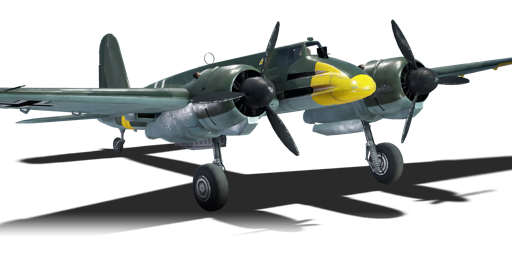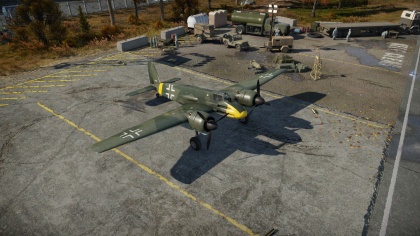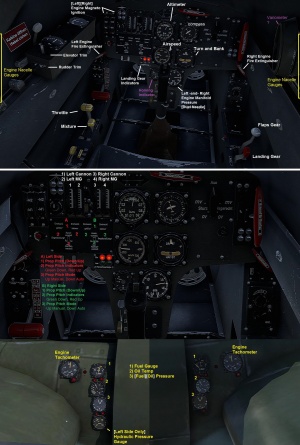Difference between revisions of "Hs 129 B-2"
Inceptor57 (talk | contribs) m |
(→Modules) (Tag: Visual edit) |
||
| Line 234: | Line 234: | ||
|- | |- | ||
|} | |} | ||
| + | Research Path: | ||
| + | |||
| + | - Radiator | ||
| + | |||
| + | - ETC 50/VIIId | ||
| + | |||
| + | - R2 Modification | ||
| + | |||
| + | - All Flight Performance/Survivability | ||
| + | |||
| + | - Weaponry | ||
| + | |||
| + | - BK 3,7 Last | ||
=== Pros and cons === | === Pros and cons === | ||
Revision as of 02:09, 7 February 2020
Contents
| This page is about the German attacker Hs 129 B-2. For other uses, see Hs 129 (Family). |
Description
The Hs 129 B-2 is a rank II German attacker
with a battle rating of 3.3 (AB), 2.3 (RB), and 2.7 (SB). This attacker has been in the game since the start of the Open Beta Test prior to Update 1.29.
The Hs 129 is a ground attack aircraft, designed mostly to take out tanks and armoured vehicles and fulfil other roles associated with CAS. Both the 30 mm MK 103 and 37 mm BK 3.7 are capable of knocking out medium tanks, light tanks, and light pillboxes while the 20 mm cannons can easily destroy armoured cars, mobile AAAs, and other lightly armoured equipment. The plane is both slow and sluggish, meaning that it practically has to go after ground targets, but the armament and armour somewhat compensate for that and enable the plane to take out nearly all ground targets except for pillboxes and heavy tanks.
General info
Flight Performance
Describe how the aircraft behaves in the air. Speed, manoeuvrability, acceleration and allowable loads - these are the most important characteristics of the vehicle.
| Characteristics | |||||||
|---|---|---|---|---|---|---|---|
| Stock | |||||||
| Max Speed (km/h at 3,550 m) |
Max altitude (meters) |
Turn time (seconds) |
Rate of climb (meters/second) |
Take-off run (meters) | |||
| AB | RB | AB | RB | AB | RB | ||
| ? | ? | 7,500 | ??.? | ??.? | ??.? | ??.? | 331 |
| Upgraded | |||||||
| Max Speed (km/h at 3,550 m) |
Max altitude (meters) | Turn time (seconds) | Rate of climb (meters/second) |
Take-off run (meters) | |||
| AB | RB | AB | RB | AB | RB | ||
| ? | ? | 7,50 | ??.? | ??.? | ?.? | ?.? | 331 |
Details
| Features | ||||
|---|---|---|---|---|
| Combat flap | Take-off flap | Landing flap | Air brakes | Arrestor gear |
| ✓ | ✓ | ✓ | X | X |
| Limits | ||||
|---|---|---|---|---|
| Wing-break speed (km/h) |
Gear limit (km/h) |
Combat flap (km/h) |
Max Static G | |
| + | - | |||
| 700 | 320 | 360 | ~13 | ~13 |
| Optimal velocities | |||
|---|---|---|---|
| Ailerons (km/h) |
Rudder (km/h) |
Elevators (km/h) |
Radiator (km/h) |
| < 310 | < 320 | < 300 | > 230 |
| Compressor (RB/SB) | ||
|---|---|---|
| Setting 1 | ||
| Optimal altitude | 100% Engine power | WEP Engine power |
| 3,000 m | 1,300 hp | 1,530 hp |
Survivability and armour
- 5 mm Steel - Oil cooler covers
- 5 mm Steel - Lower engine cowl protection
- 2 mm Steel - Cockpit side plates
- 12 mm Steel - Cockpit back plate, floor, and front plates
- 75 mm Bulletproof glass
Armaments
Offensive armament
The Hs 129 B-2 is armed with:
- 2 x 20 mm MG 151/20 cannon, fuselage-mounted (250 rpg = 500 total)
- 2 x 7.92 mm MG 17 machine gun, fuselage-mounted (1,000 rpg = 2,000 total)
Suspended armament
The Hs 129 B-2 can be outfitted with the following ordnance:
- 1 x 30 mm MK 103 cannon, belly-mounted (100 rpg)
- 1 x 37 mm BK 3,7 cannon, belly-mounted (12 rpg)
- 4 x 50 kg SC50JA bombs (200 kg total)
Usage in battles
The plane is very heavy, which makes it nearly impossible to take out fighters (unless the fighters come to the Hs 129 B-2, see below), even most medium bombers are more maneuverable, however the plane is heavily armoured, so it can last a while even under heavy fire, even to such a degree that some planes run out of ammunition before taking out a Henschel. That combined with the heavy armament makes it ideal to attack B-17 formations, even though it requires time and effort to climb and match the speed of the formation. The armour around the cockpit makes it nearly immune to 7.92 mm rounds and could also fly with one engine, albeit with great difficulty. The planes incredibly stable flight behaviour makes aiming even for joystick pilots very easy and accurate thus not wasting too much ammunition.
Once the 30 mm additional gun with its impressive 100-round belt has been researched (the 37 mm with its smaller belt and low rate of fire should be avoided), the plane has very heavy firepower. In combination with the great stability and thus firing accuracy, this makes it an ideal heads-on fighter. With a bit of experience, it's relatively easy to finish off enemy fighters with one or two short bursts before they are even in range for the target indicator to appear. In situations where enemy planes coming at 0.5 to 1.0 km interval from the same direction, the Hs 129 B-2 can easily achieve triple or even quadruple air victories before needing to turn around for reloading.
Tactics
Using the 30 mm MK 103, which can be unlocked as an additional armament option, the Hs 129 B-2 is capable of destroying most mission relevant ground targets. Tanks of all sorts, as well as light pillboxes, can be destroyed in up to three hits, provided armour piercing ammunition (HVAP-T) is unlocked. Thanks to the 100 rounds of ammunition available, this can make a single Hs 129B-2 a game-changing aircraft. The same can be achieved using the BK 3.7, however, it is generally considered harder to use and thus not a viable option.
The Hs 129 B-2, however, does have major drawbacks. Its engines are weak which results in poor top speed, acceleration and climb rate. This, combined with the armour of nearly one-ton weight, makes it perform poorly in air combat and very vulnerable to attacks of enemy fighters. This, however, goes so far that sometimes enemy pilots underestimate the Hs 129 and overshoot it after a tight turn, which gives the Hs 129B-2 pilot a moderate chance of defending itself.
Manual Engine Control
| MEC elements | ||||||
|---|---|---|---|---|---|---|
| Mixer | Pitch | Radiator | Supercharger | Turbocharger | ||
| Oil | Water | Type | ||||
| Controllable | Not controllable | Not controllable | Not controllable | Separate | Not controllable | Not controllable |
Modules
| Tier | Flight performance | Survivability | Weaponry | |||
|---|---|---|---|---|---|---|
| I | Fuselage Repair | Radiator | Offensive 7 mm | Offensive 20 mm | ETC 50/VIIId | |
| II | Compressor | Airframe | New 7 mm MGs | New 20 mm Cannons | R2 Modification | |
| III | Wing Repair | Engine | Offensive 30 mm | Offensive 37 mm | BK 3,7 Cannon | |
| IV | Engine Injection | Cover | New 30 mm Cannons | New 37 mm Cannons | ||
Research Path:
- Radiator
- ETC 50/VIIId
- R2 Modification
- All Flight Performance/Survivability
- Weaponry
- BK 3,7 Last
Pros and cons
Pros:
- Resistant to light machine guns and Russian heavy machineguns
- Very good firepower when carrying either the 30 mm or 37 mm cannon pods
- 30 mm MK 103 is a high-velocity cannon with a decent rate of fire, which allows for versatility in targets, and is especially devastating against armoured vehicles
- 30 mm HVAP-T generally destroys air targets in one to three hits with a high potential to combust targets
- 30 mm HE-I/HEI-T Minengeschoß in the default belts means grinding once the 30 mm is available isn't that difficult
- 30 mm has a reasonable ammo pool of 100 rounds and the low fire rate combined with hit success allows it more than enough to obtain down five planes before running out
- Cockpit has 70 mm of armoured glass at the front, reasonable all-round protection for the pilot
- Great at head-on passes in all game modes (shoot and duck/rollaway)
- Centrally mounted armament, need for gun harmonisation minimalized
Cons:
- Poor climb rate, bad manoeuvrability, heavy aircraft
- The engines are underpowered and if even one is shot-up, the plane will fall from the sky
- Engine uses a carburettor, preventing prolonged inverted G-load state
- Has no defensive armament compared to other attack aircraft of its rank
- Engine and internal wing fuel tanks are ideal targets for enemy pilots
- Needs the gun pods to do well
- Thick cockpit armoured glass causes some distortion (simulator)
History
Describe the history of the creation and combat usage of the aircraft in more detail than in the introduction. If the historical reference turns out to be too big, take it to a separate article, taking a link to the article about the vehicle and adding a block "/ History" (example: https://wiki.warthunder.com/(Vehicle-name)/History) and add a link to it here using the main template. Be sure to reference text and sources by using <ref>, as well as adding them at the end of the article. This section may also include the vehicle's dev blog entry (if applicable) and the in-game encyclopedia description (under === Encyclopedia Info ===, also if applicable).
In-game description
"The German Henschel Hs-129 was a single-seater twin-engine attack aircraft built for combat with tanks.
For the designers of the Henschel firm, which specialized in the manufacture of armored vehicles for the Army, the most difficult challenge was aircraft survivability. They sought to protect the pilot and the most vulnerable components of the aircraft. Their desire to keep mass as low as possible led them to build a cockpit encased in 75 millimeters of glass. The design was very cramped and poorly regarded. Among other inconveniences were the tiny control panel and short control stick.
During flight testing, it was found that the aircraft could not dive, since any angle greater than 30 degrees resulted in the pilot being unable to control the aircraft. In addition, it was found that the Hs-129 could not fly well on one engine. This fact, combined with the reasoning that the plane could land using the other engine should its partner fail, led to the plane’s twin-engine design.
Despite the plane’s shortcomings, the Luftwaffe desperately needed aircraft for the assault of 1940, and in the winter of 1940, Henschel received an order for a series of Hs-129 planes. With the occupation of France, a large number of Gnome-Rhone 14M engines were confiscated, each running at 700 hp. Experiments with installing more powerful (albeit unreliable) engines led to the creation of the Hs-129B, which had superior specs to the original Hs-129 and could return all the way to base if forced to fly with only one engine.
Serial production of the Hs-129B-1 began in 1941, and May of the following year saw the launch of the modified Hs-129B-2, which had a modified fuel system (along with several other minor changes).
All in all, 878 Hs-129s were produced."
Media
Excellent additions to the article would be video guides, screenshots from the game, and photos.
See also
External links
Paste links to sources and external resources, such as:
- topic on the official game forum;
- encyclopedia page on the aircraft;
- other literature.
| Henschel & Son Corporation (Henschel und Sohn Aktiengesellschaft) | |
|---|---|
| Attackers | Hs 129 B-2 · Hs 129 B-3 |
| Bombers | Hs 123 A-1 |
| Export | ␗Hs 123 A-1 |
| Hs 129 B-2 (Romania) · Hs 129 B-2 (Romania) | |
| Germany strike aircraft | |
|---|---|
| Messerschmitt | |
| Bf 110 | Bf 110 C-6 · Bf 110 C-7 · Bf 110 F-2 · Bf 110 G-2 · Bf 110 G-4 |
| Me 410 | Me 410 A-1 · Me 410 A-1/U4 · Me 410 B-1 · Me 410 B-2/U4 · Me 410 B-6/R3 |
| Dornier | |
| Do 335 | Do 335 A-0 · Do 335 A-1 · Do 335 B-2 |
| Focke-Wulf | |
| Fw 190 | Fw 190 F-8 |
| Heinkel | |
| He 219 | He 219 A-7 |
| Henschel | |
| Hs 129 | Hs 129 B-2 · Hs 129 B-2 (Romania) · Hs 129 B-3 |
| Junkers | |
| Ju 87 | Ju 87 G-1 · Ju 87 G-2 |
| Foreign: | |
| USSR | ▀IL-2 (1942) |






